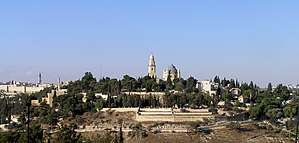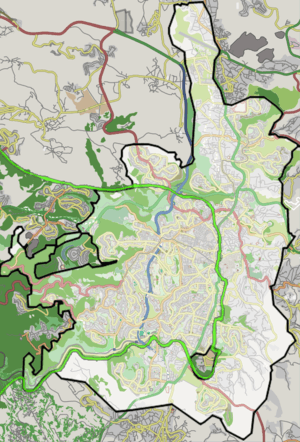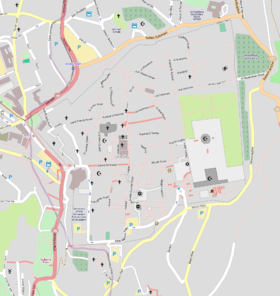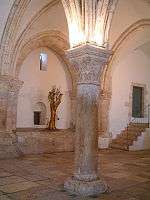Mount Zion
Mount Zion (Hebrew: הַר צִיּוֹן, Har Tsiyyon; Arabic: جبل صهيون, Jabal Sahyoun) is a hill in Jerusalem, located just outside the walls of the Old City. The term Mount Zion has been used in the Hebrew Bible first for the City of David (2 Samuel 5:7, 1 Chronicles 11:5; 1 Kings 8:1, 2 Chronicles 5:2) and later for the Temple Mount, but its meaning has shifted and it is now used as the name of ancient Jerusalem's Western Hill.[1][2] In a wider sense, the term is also used for the entire Land of Israel.[3]
| Mount Zion | |
|---|---|
| הַר צִיוֹן (Har Tsiyyon) جبل صهيون (Jabel Sahyoun) | |
 | |
| Highest point | |
| Elevation | 765 m (2,510 ft) |
| Coordinates | 31°46′18″N 35°13′43″E |
| Geography | |
 Mount Zion Location within Jerusalem  Mount Zion Location within the Old City of Jerusalem | |
| Location | Jerusalem |
| Parent range | Judean |
Etymology
The etymology of the word Zion is uncertain.[4][5][6] Mentioned in the Bible in the Book of Samuel (2 Samuel 5:7) as the name of the Jebusite fortress conquered by King David, its origin likely predates the Israelites.[4][5] If Semitic, it may be associated with the Hebrew root ''ṣiyyôn ("castle"). Though not spoken in Jerusalem until hundreds of years later, the name is similar in Arabic and may be connected to the root ṣiyya ("dry land") or the Arabic šanā ("protect" or "citadel").[5][6] It might also be related to the Arabic root ṣahî ("ascend to the top") or ṣuhhay ("tower" or "the top of the mountain").[6] A non-Semitic relationship to the Hurrian word šeya ("river" or "brook") has also been suggested.[6]
Sahyun (Arabic: صهيون, Ṣahyūn or Ṣihyūn) is the word for Zion in Arabic and Syriac.[7] A valley called Wâdi Sahyûn (wadi being the Arabic for "valley") seemingly preserves the name and is located approximately one and three-quarter miles (2.8 km) from the Old City of Jerusalem's Jaffa Gate.[7]
The phrase Har Tzion, lit. "Mount Zion", appears nine times in the Tanakh.[8] It is spelled with a Tzadi and not Zayin.[9]
The three different locations
The name Mount Zion referred successively to three locations, as Jerusalemites preserved the time-honoured name, but shifted the location they venerated as the focal point of biblical Jerusalem to the site considered most appropriate in their own time.
Lower Eastern Hill (City of David)
At first, Mount Zion was the name given to the Jebusite fortified city on the lower part of ancient Jerusalem's Eastern Hill, also known as the City of David.[1]
According to the Book of Samuel, Mount Zion was the site of the Jebusite fortress called the "stronghold of Zion" that was conquered by King David, then renamed and partially rebuilt by him as the "City of David", where he erected his palace.[1]
Upper Eastern Hill (Temple Mount)
Once the First Temple was erected at the top of the Eastern Hill, the name "Mount Zion" migrated there too.[1]
After the conquest of the Jebusite city, its built-up area expanded northward towards the uppermost part of the same, Eastern Hill. This highest part became the site of Solomon's Temple.
The identification of the pre-Israelite (Jebusite) and Israelite towns on the Eastern Hill is based on the existence of only one perennial water source in the area, the Gihon Spring, and on archaeological excavations revealing sections of the Bronze Age and Iron Age city walls and water systems.[1][10]
The "Mount Zion" mentioned in the later parts of the Book of Isaiah (Isaiah 60:14), in the Book of Psalms, and the First Book of Maccabees (c. 2nd century BCE) seems to refer to the top of the hill, generally known as the Temple Mount.[1]
Western Hill (today's Mount Zion)

The last shift of the name Mount Zion was to the Western Hill, which is more dominant than the Eastern Hill and seemed to first-century CE Jerusalemites the worthier location for the by-then lost palace of King David. The Western Hill is what today is called Mount Zion.[1]
In the second half of the First Temple period, the city expanded westward and its defensive walls were extended to include the entire Western Hill behind them.[11] Nebuchadnezzar II destroyed the city almost completely around 586 BCE, severing the continuity of historical memory. A long period of rebuilding followed, ending with Jerusalem's second total destruction at the hands of the Romans in 70 CE. Josephus, the first-century CE historian who knew the city as it was before this second catastrophic event, identified Mount Zion as being the Western Hill, separated from the lower, Eastern Hill, by what he calls the "Tyropoeon Valley".[1] It must however be said that Josephus never used the name "Mount Zion" in any of his writings, but described the "Citadel" of King David as being situated on the higher and longer hill, thus pointing at the Western Hill as what the Bible calls Mount Zion.[12][13]
History since the Late Roman period
At the end of the Roman period, a synagogue was built at the entrance of the structure known as David's Tomb, probably based on the belief that David brought the Ark of the Covenant here from Beit Shemesh and Kiryat Ye'arim before the construction of the Temple.[14]
During the 1948 war, Mount Zion was conquered by the Harel Brigade on May 18, 1948 and became the only part of the Old City to stay in Israeli hands until the armistice. At first it was linked to the Jewish neighborhood of Yemin Moshe across the Valley of Hinnom via a narrow tunnel, but eventually an alternative was needed to evacuate the wounded and transport supplies to soldiers on Mt. Zion. A cable car capable of carrying a load of 250 kilograms was designed for this purpose. The cable car was only used at night and lowered into the valley during the day to escape detection; it is still in place at what is now the Mount Zion Hotel. The ride from the Israeli position at the St. John Eye Hospital to Mount Zion took two minutes.[15]
Between 1948 and 1967, when the Old City was under Jordanian rule, Israelis were forbidden access to the Jewish holy places. Mount Zion was a designated no-man's land between Israel and Jordan.[16] Mount Zion was the closest accessible site to the ancient Jewish Temple. Until East Jerusalem was captured by Israel in the Six-Day War, Israelis would climb to the rooftop of David's Tomb to pray.[17] The winding road leading up to Mount Zion is known as Pope's Way (Derekh Ha'apifyor). It was paved in honor of the historic visit to Jerusalem of Pope Paul VI in 1964.[16]
Biblical references

The Tanakh reference to Har Tzion (Mount Tzion) that identifies its location is derived from the Psalm 48 composed by the sons of Korah, i.e. Levites, as "the northern side of the city of the great king", which Radak interprets as the City of David "from the City of David, which is Zion (1 Kings 8:1-2; 2 Chron. 5:2)".[18] 2 Samuel 5:7 also reads, "David took the strong hold of Zion: the same is the city of David," which identifies Mount Tzion as part of the City of David, and not an area outside today's Old City of Jerusalem. Rashi identifies the location as the source of "joy" mentioned in the Psalm as the Temple Courtyard, the location of atonement offerings in the northern part of the Temple complex.[19]
In the New Testament, Mount Zion is used metaphorically to refer to the heavenly Jerusalem, God's holy, eternal city. Christians are said to have “ . . . come to Mount Zion and to the city of the living God, the heavenly Jerusalem, to an innumerable company of angels, to the general assembly and church of the firstborn who are registered in heaven” (Hebrews 12:22-23 cf. Revelation 14:1).
Landmarks

Important sites on Mount Zion are Dormition Abbey, King David's Tomb and the Room of the Last Supper. Most historians and archeologists today do not regard "David's Tomb" there to be the actual burial place of King David. The Chamber of the Holocaust (Martef HaShoah), the precursor of Yad Vashem, is also located on Mount Zion. Another place of interest is the Catholic cemetery where Oskar Schindler, a Righteous Gentile who saved the lives of 1,200 Jews in the Holocaust, is buried.[20]
Notable burials in the Protestant cemetery on Mt. Zion include a number of prominent individuals from the 19th and 20th centuries. These include explorers and archaeologists such as: Flinders Petrie, Charles Frederick Tyrwhitt Drake, James Duncan, Clarence Stanley Fisher, Charles Lambert and James Leslie Starkey; the architect Conrad Schick; and pioneers in the fields of medicine, education, religion, diplomacy and social services such as James Edward Hanauer, Ernest Masterman, John Nicholayson, Paul Palmer, Max Sandreczky, Johann Ludwig Schneller, Horatio G. Spafford, author of the hymn It Is Well With My Soul. Also buried in the cemetery are G. Douglas Young, founder of Jerusalem University College, and his wife Georgina (Snook) Young. The cemetery is also the final resting place for a number of soldiers who fought in the First World War, as well as members of the Palestinian Police who served under the British mandate. Several persons buried here were killed in the bombing of the King David Hotel on the morning of 22 July 1946.
Archaeology
In 1874, an Englishman, Henry Maudsley, discovered a large segment of rock scarp and numerous ancient dressed stones on Mount Zion that were believed to be the base of Josephus's First Wall. Several of these stones were used to construct a retaining wall outside the main gate of the Bishop Gobat school (later known as the American Institute of Holy Land Studies and Jerusalem University College).[21]
See also
References
- Bargil Pixner (2010). Rainer Riesner (ed.). Paths of the Messiah. Translated by Keith Myrick, Miriam Randall. Ignatius Press. pp. 320–322. ISBN 978-0-89870-865-3.
- The Significance of Jerusalem: A Jewish Perspective
- Menashe Harel (1977). This is Jerusalem. Jerusalem: Canaan Publishing. pp. 194–195.
- Terry R. Briley (2000). Isaiah, Volume 1 - The College Press NIV commentary: Old Testament series. College Press. p. 49. ISBN 978-0-89900-890-5.
- Tremper Longman, Peter Enns (2008). Tremper Longman, Peter Enns (ed.). Dictionary of the Old Testament: wisdom, poetry & writings, Volume 3 (Illustrated ed.). InterVarsity Press. p. 936. ISBN 978-0-8308-1783-2.
- Geoffrey W. Bromiley (1982). Geoffrey W. Bromiley (ed.). International Standard Bible Encyclopedia: E-J Volume 2 (Revised ed.). Wm. B. Eerdmans Publishing. p. 1006. ISBN 978-0-8028-3782-0.
- Palestine Exploration Fund (1977). Palestine exploration quarterly. Published at the Fund's Office. p. 21.
- The Responsa Project: Version 13, Bar Ilan University, 2005
- Kline, D.E., A Comprehensive Etymological Dictionary of the Hebrew Language for readers of English, Carta Jerusalem, The University of Haifa, 1987, pp.XII-XIII
- Menashe Harel (1977). This is Jerusalem. Jerusalem: Canaan Publishing. p. 193.
- Menashe Harel (1977). This is Jerusalem. Jerusalem: Canaan Publishing. p. 272.
- Flavius Josephus. The Wars of the Jews or History of the Destruction of Jerusalem. Translated by William Whiston. Project Gutenberg. Retrieved February 2016.
The city was built upon two hills, which are opposite to one another, and have a valley to divide them asunder; [...] Of these hills, that which contains the upper city is much higher, and in length more direct. Accordingly, it was called the "Citadel," by king David; [...] Now the Valley of the Cheesemongers, as it was called, and was that which we told you before distinguished the hill of the upper city from that of the lower,... (Book 5, Chapter 4, §1; or V:137)
Check date values in:|accessdate=(help) - The genuine works of Flavius Josephus..., translated by William Whiston, Havercamp edition, New York (1810). See footnote on page 83. (copy&pg=PA83 Mount Zion, p. 83, at Google Books)
- Menashe Harel (1977). This is Jerusalem. Jerusalem: Canaan Publishing. p. 273.
- Mt. Zion Cable Car Archived 2012-08-13 at the Wayback Machine
- Bar-Am, Aviva. "On the spot". Jerusalem Post. Retrieved 2007-10-23.
- Jerusalem Divided: The Armistice Regime, 1947-1967, Raphael Israeli, Routledge, 2002, p. 6
- Ronald L. Eisenberg, The streets of Jerusalem: who, what, why, Devora Publishing, 2006, p.169
- Menachem Davis, ed., The Book of Psalms, Mesorah Publications, New York, 2001, p.128
- Rubinstein, Danny. "A sign points to the grave". Haaretz.com. Retrieved 2007-10-23.
- Pixner, Bargil (June 1997). Shanks, Hershel (ed.). "Where the Community Lived in Jesus' Time". Biblical Archaeology Review. Biblical Archaeology Society. Archived from the original on 19 January 2015. Retrieved 14 March 2020 – via Jerusalem's Essene Gateway.
External links
![]()